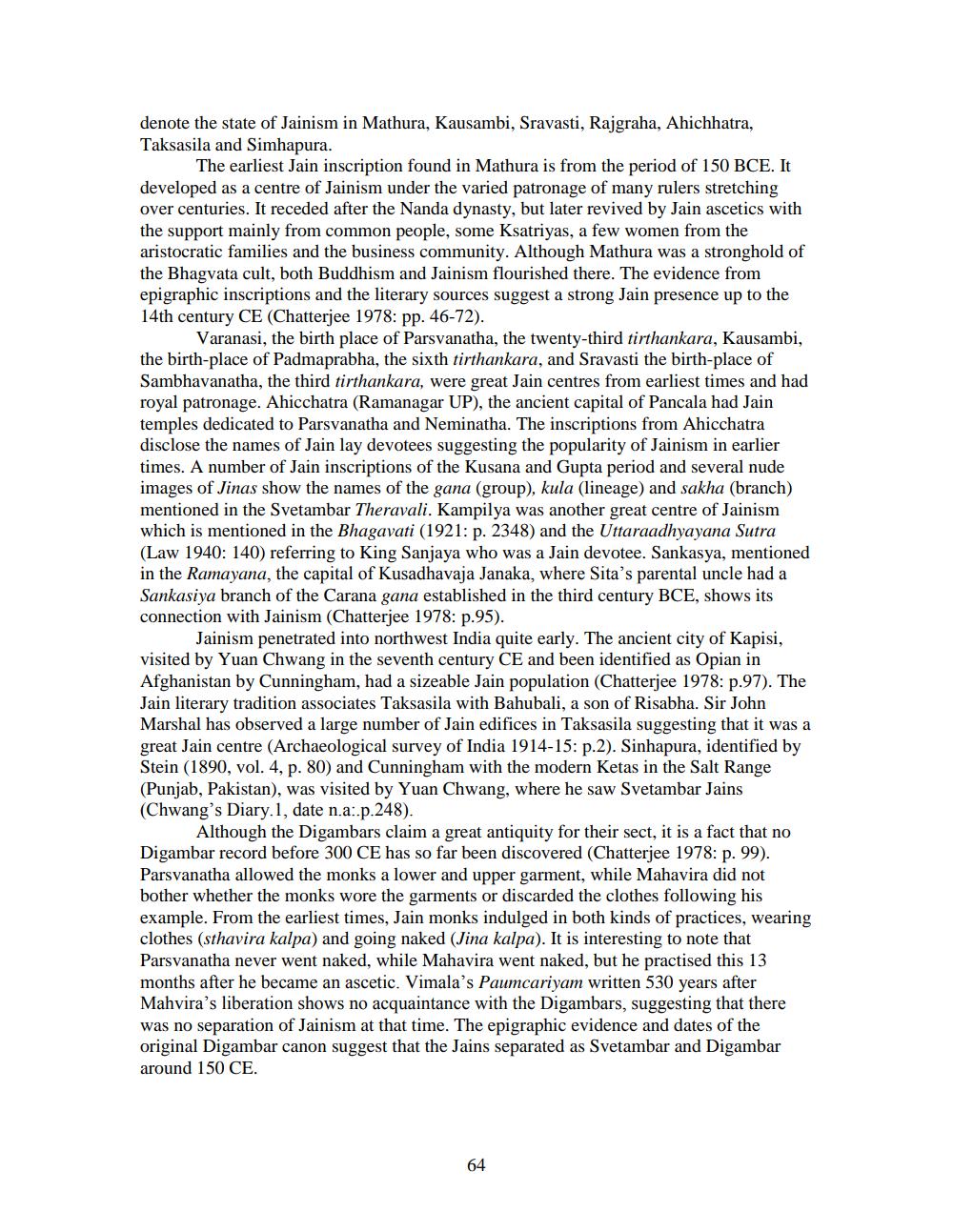________________
denote the state of Jainism in Mathura, Kausambi, Sravasti, Rajgraha, Ahichhatra, Taksasila and Simhapura.
The earliest Jain inscription found in Mathura is from the period of 150 BCE. It developed as a centre of Jainism under the varied patronage of many rulers stretching over centuries. It receded after the Nanda dynasty, but later revived by Jain ascetics with the support mainly from common people, some Ksatriyas, a few women from the aristocratic families and the business community. Although Mathura was a stronghold of the Bhagvata cult, both Buddhism and Jainism flourished there. The evidence from epigraphic inscriptions and the literary sources suggest a strong Jain presence up to the 14th century CE (Chatterjee 1978: pp. 46-72).
Varanasi, the birth place of Parsvanatha, the twenty-third tirthankara, Kausambi, the birth-place of Padmaprabha, the sixth tirthankara, and Sravasti the birth-place of Sambhavanatha, the third tirthankara, were great Jain centres from earliest times and had royal patronage. Ahicchatra (Ramanagar UP), the ancient capital of Pancala had Jain temples dedicated to Parsvanatha and Neminatha. The inscriptions from Ahicchatra disclose the names of Jain lay devotees suggesting the popularity of Jainism in earlier times. A number of Jain inscriptions of the Kusana and Gupta period and several nude images of Jinas show the names of the gana (group), kula (lineage) and sakha (branch) mentioned in the Svetambar Theravali. Kampilya was another great centre of Jainism which is mentioned in the Bhagavati (1921: p. 2348) and the Uttaraadhyayana Sutra (Law 1940: 140) referring to King Sanjaya who was a Jain devotee. Sankasya, mentioned in the Ramayana, the capital of Kusadhavaja Janaka, where Sita's parental uncle had a Sankasiya branch of the Carana gana established in the third century BCE, shows its connection with Jainism (Chatterjee 1978: p.95).
Jainism penetrated into northwest India quite early. The ancient city of Kapisi, visited by Yuan Chwang in the seventh century CE and been identified as Opian in Afghanistan by Cunningham, had a sizeable Jain population (Chatterjee 1978: p.97). The Jain literary tradition associates Taksasila with Bahubali, a son of Risabha. Sir John Marshal has observed a large number of Jain edifices in Taksasila suggesting that it was a great Jain centre (Archaeological survey of India 1914-15: p.2). Sinhapura, identified by Stein (1890, vol. 4, p. 80) and Cunningham with the modern Ketas in the Salt Range (Punjab, Pakistan), was visited by Yuan Chwang, where he saw Svetambar Jains (Chwang's Diary.1, date n.a:.p.248).
Although the Digambars claim a great antiquity for their sect, it is a fact that no Digambar record before 300 CE has so far been discovered (Chatterjee 1978: p. 99). Parsvanatha allowed the monks a lower and upper garment, while Mahavira did not bother whether the monks wore the garments or discarded the clothes following his example. From the earliest times, Jain monks indulged in both kinds of practices, wearing clothes (sthavira kalpa) and going naked (Jina kalpa). It is interesting to note that Parsvanatha never went naked, while Mahavira went naked, but he practised this 13 months after he became an ascetic. Vimala's Paumcariyam written 530 years after Mahvira's liberation shows no acquaintance with the Digambars, suggesting that there was no separation of Jainism at that time. The epigraphic evidence and dates of the original Digambar canon suggest that the Jains separated as Svetambar and Digambar around 150 CE.
64




